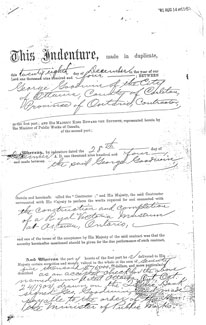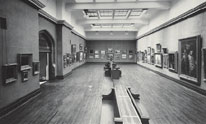- Home>
- About Us>
- History and Buildings>
- Historical Timeline
© National Archives of Canada; Martin Lipman © Canadian Museum of Nature
Close.Historical Timeline
1842
Museum Origins
Creation of the Geological Survey of Canada. In the ensuing decades, the survey's researchers explore not only the geology of the former Province of Canada, but also collect specimens of flora and fauna.
© Canadian Museum of Nature
The first page of the 1904 contract to build the museum building.
1856
Museum Origins
In 1856 Sir William Logan, the first director of the Geological Survey, is authorized to "establish a Geological Museum at some convenient place which shall be open at all seasonable hours to be public".
1880
Museum Origins
The Survey opened a museum in its headquarters in Montréal, and so Logan is considered by many to be the founding father of Canada's national museums. The Survey moves to Ottawa's Byward Market in 1880.
1882
Museum Origins
The Survey hires its first naturalist, John Macoun, a 51-year-old botanist. Macoun would lead the development of the first natural-history collections for the museum.
1901
Building Construction
Parliament authorizes commencement of the construction of the Victoria Memorial Museum in 1901 under the direction of chief architect David Ewart. The building is to be a tribute to Queen Victoria, whose 64-year reign ended in that year.
William James Topley © National Archives of Canada
Most of the stone used to build the museum was carved by hand.
1903
Building Construction
In 1903, Supreme Court Justice William Stewart's 3.6 hectare (9 acre) cow pasture is chosen on what was then the outskirts of Ottawa. It is located exactly one mile south of Parliament Hill.
1905
Building Construction
Work begins on a massive new building formed out of local sandstone. Three hundred Scottish stonemasons are brought across the Atlantic to work on the building. The contract is to cost $950 000 (the value at the time; figure not adjusted for inflation to today).
1910
Building Construction
The core construction of the museum is completed. Work continues in the interior, with staff preparing the displays of minerals, fossils and birds.
1911
Famous Tenants: National Museums' Birthplace
The National Gallery of Canada displays its art treasures on the building's fourth floor.
© Library and Archives Canada
Visitors in a gallery circa 1912.
1912
Open to Visitors
The Victoria Memorial Museum Building opens to the public.
1913
Open to Visitors
On January 20, Canada's first fossil gallery opens. In July, the first dinosaur to ever be displayed in Canada is rolled out. The dinosaur—a hadrosaur named Edmontosaurus regalis—still captivates visitors in the museum's current fossil gallery.
1915
Building Construction
Because of unstable ground, the building started sinking before it was completed. In 1915, 24 metres (80 ft.) of the museum's tower is removed because the foundation cannot hold the weight.
© Library and Archives Canada
Canada's House of Commons in session in the theatre at the Victoria Memorial Museum. Prime Minister Sir Robert Borden is sitting at left near the back, and Liberal leader Sir Wilfrid Laurier is sitting at right near the back.
1916
Famous Tenants: Parliament
In 1916, the building becomes the emergency headquarters of the Canadian government after the Parliament Buildings are consumed by a great fire. The government stayed for four years.
1919
Famous Tenants: Parliament
When former Prime Minister Sir Wilfrid Laurier dies in 1919, his body is lain in state in the museum's auditorium.
1920
Famous Tenants: Parliament
The Parliament of Canada leaves.
1927
Museum Origins
The National Museum of Canada and the Geological Survey are formally separated into distinct entities by the federal government. They remain in the building together.
1956
Famous Tenants: National Museums' Birthplace
The National Museum of Canada is divided into two branches: the National Museum of Natural Sciences, dedicated to natural history, and the National Museum of Man, representing human history.
© Library and Archives Canada
Early days of the National Gallery of Canada in the Victoria Memorial Museum Building.
1957–1989
Famous Tenants: National Museums' Birthplace
The National Museum of Man occupies approximately half of the museum building until it leaves for to its present location in Gatineau, Quebec, a few years after becoming the Canadian Museum of Civilization in 1986. (It is then renamed the Canadian Museum of History in 2014).
1959
Famous Tenants: National Museums' Birthplace
The Geological Survey of Canada leaves the building, relocating to Booth Street in Ottawa. The National Gallery of Canada also leaves, relocating to a new building in downtown Ottawa.
1960s
Famous Tenants: National Museums' Birthplace
Artist Clarence Tillenius completes his landmark dioramas, which depict iconic Canadian mammals in habitats across Canada. The dioramas remain on view to this day.
1967
Famous Tenants: National Museums' Birthplace
The fourth national museum has its start at the building: an offshoot of the Museum of Man, the National Museum of Science and Technology—now the Canada Science and Technology Museum—is created and opens at its present location in Ottawa.
© Canadian Museum of History
The Museum of Man was a tenant in the building until 1989. It was renamed the Canadian Museum of Civilization at that time, and is now the Canadian Museum of History.
1969–1974
Building Construction
The Victoria Memorial Museum Building continues to sink until 1969. The museum is closed for stabilization against sinking, infrastructure upgrades and new galleries. The work costs $6 000 000 (the value at the time; figure not adjusted for inflation to today).
1990
Museum Origins
The National Museum of Natural Sciences becomes the Canadian Museum of Nature. It becomes the sole occupant of the museum building after the Canadian Museum of Civilization (previously National Museum of Man) leaves for a new building of its own.
1995–1997
Building Construction
The exterior of the museum's heritage stonework is cleaned and repaired.
1997
Building Construction: New Research Facility
The Canadian Museum of Nature opens a new research and collections facility in Gatineau, Quebec. This building consolidates the museum's administration, laboratories, science experts and national collections of fossils, plants, minerals and animals under one roof.
Martin Lipman © Canadian Museum of Nature
New steel reinforcement helps protect the museum from earthquake damage.
2004–2010
Building Construction: Renewal
Significant construction and renovation work on the museum begins. This is the most comprehensive renovation of the historic building. Interiors are gutted, an interior steel skeleton is installed, new building and climate-control systems are added, additions are constructed and new galleries are installed. The federal government provides $216 million in funding for the building (the value at the time; figure not adjusted for inflation to today), while corporate support and donations fund the new gallery content.
2010
Building Construction: Renewal
The renewal of the museum is completed and the entirely renovated museum building is celebrated on May 22—International Day for Biological Diversity. Queen Elizabeth II dedicates the new glass tower in June. It is called the Queens' Lantern for both Victoria and Elizabeth II.










